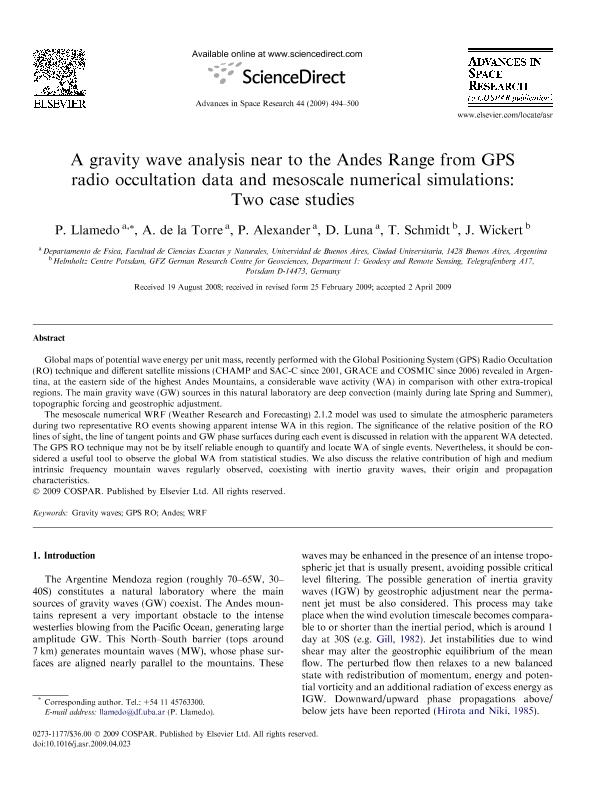Mostrar el registro sencillo del ítem
dc.contributor.author
Llamedo, P
dc.contributor.author
de la Torre, Alejandro

dc.contributor.author
Alexander, Pedro Manfredo

dc.contributor.author
Luna, D.
dc.contributor.author
Schmidt, T.
dc.contributor.author
Wickert, J.
dc.date.available
2018-09-24T14:42:38Z
dc.date.issued
2009-08
dc.identifier.citation
Llamedo, P; de la Torre, Alejandro; Alexander, Pedro Manfredo; Luna, D.; Schmidt, T.; et al.; A gravity wave analysis near to the Andes Range from GPS radio occultation data and mesoscale numerical simulations: Two case studies; Elsevier; Advances in Space Research; 44; 4; 8-2009; 494-500
dc.identifier.issn
0273-1177
dc.identifier.uri
http://hdl.handle.net/11336/60716
dc.description.abstract
Global maps of potential wave energy per unit mass, recently performed with the Global Positioning System (GPS) Radio Occultation (RO) technique and different satellite missions (CHAMP and SAC-C since 2001, GRACE and COSMIC since 2006) revealed in Argentina, at the eastern side of the highest Andes Mountains, a considerable wave activity (WA) in comparison with other extra-tropical regions. The main gravity wave (GW) sources in this natural laboratory are deep convection (mainly during late Spring and Summer), topographic forcing and geostrophic adjustment. The mesoscale numerical WRF (Weather Research and Forecasting) 2.1.2 model was used to simulate the atmospheric parameters during two representative RO events showing apparent intense WA in this region. The significance of the relative position of the RO lines of sight, the line of tangent points and GW phase surfaces during each event is discussed in relation with the apparent WA detected. The GPS RO technique may not be by itself reliable enough to quantify and locate WA of single events. Nevertheless, it should be considered a useful tool to observe the global WA from statistical studies. We also discuss the relative contribution of high and medium intrinsic frequency mountain waves regularly observed, coexisting with inertio gravity waves, their origin and propagation characteristics. © 2009 COSPAR.
dc.format
application/pdf
dc.language.iso
eng
dc.publisher
Elsevier

dc.rights
info:eu-repo/semantics/openAccess
dc.rights.uri
https://creativecommons.org/licenses/by-nc-sa/2.5/ar/
dc.subject
Andes
dc.subject
Gps Ro
dc.subject
Gravity Waves
dc.subject
Wrf
dc.subject.classification
Meteorología y Ciencias Atmosféricas

dc.subject.classification
Ciencias de la Tierra y relacionadas con el Medio Ambiente

dc.subject.classification
CIENCIAS NATURALES Y EXACTAS

dc.title
A gravity wave analysis near to the Andes Range from GPS radio occultation data and mesoscale numerical simulations: Two case studies
dc.type
info:eu-repo/semantics/article
dc.type
info:ar-repo/semantics/artículo
dc.type
info:eu-repo/semantics/publishedVersion
dc.date.updated
2018-09-18T16:31:37Z
dc.journal.volume
44
dc.journal.number
4
dc.journal.pagination
494-500
dc.journal.pais
Países Bajos

dc.journal.ciudad
Amsterdam
dc.description.fil
Fil: Llamedo, P. Universidad de Buenos Aires. Facultad de Ciencias Exactas y Naturales. Departamento de Física; Argentina
dc.description.fil
Fil: de la Torre, Alejandro. Consejo Nacional de Investigaciones Científicas y Técnicas; Argentina. Universidad de Buenos Aires. Facultad de Ciencias Exactas y Naturales. Departamento de Física; Argentina
dc.description.fil
Fil: Alexander, Pedro Manfredo. Consejo Nacional de Investigaciones Científicas y Técnicas; Argentina. Universidad de Buenos Aires. Facultad de Ciencias Exactas y Naturales. Departamento de Física; Argentina
dc.description.fil
Fil: Luna, D.. Universidad de Buenos Aires. Facultad de Ciencias Exactas y Naturales. Departamento de Física; Argentina
dc.description.fil
Fil: Schmidt, T.. German Research Centre for Geosciences; Alemania
dc.description.fil
Fil: Wickert, J.. German Research Centre for Geosciences; Alemania
dc.journal.title
Advances in Space Research

dc.relation.alternativeid
info:eu-repo/semantics/altIdentifier/doi/https://dx.doi.org/10.1016/j.asr.2009.04.023
dc.relation.alternativeid
info:eu-repo/semantics/altIdentifier/url/https://www.sciencedirect.com/science/article/pii/S0273117709002385
Archivos asociados
